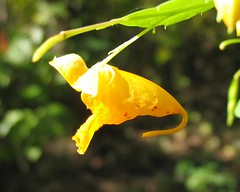Matt and I were driving down the Beltway not too long ago when we realized a bald eagle was flying overhead. That this is even possible is such a potent reminder of how far these birds have come in our lifetime.

Bald eagle at the National Zoo by
geopungoWhen I was born, bald eagles were on the brink of extinction. In the early 1970s, there were only about 400 nesting pairs recorded in the lower 48 states. They were one of the original species listed when the Endangered Species List was created in 1973.
With that legal protection from hunting and habitat destruction, plus the banning of DDT in 1972, bald eagles have made an amazing recovery. By 2007, it was estimated that there were more than 10,000 nesting pairs in the continental US -- enough that they were removed from the Endangered Species List that year. (They're still protected by the
Bald and Golden Eagle Protection Act.)
Bald eagles like to nest near water (they eat fish). They avoid nesting near buildings and people -- with the exception of a few city slickers, including
some who have nested in the District. With these requirements, and with each nesting pair defending a territory of about 250 acres, their nesting options are limited. But there are a few protected waterfront locations around the DC metro area that suit bald eagles just fine. We see an eagle almost every time we go to
Jug Bay, for example. Farther afield, Blackwater National Wildlife Refuge on Maryland's Eastern Shore is reported to have a population of over a hundred eagles.
Eagles are the largest bird of prey you're likely to see near Washington, DC: they have a 6+ foot wingspan. They take their name from their all-white head (in Latin, too:
Haliaeetus leucocephalus means sea eagle with a white (
leukos) head (
cephalus)). But for me, what really distinguishes them in flight is the all-white tail. Ospreys are smaller and have a mostly-white head, but not that white tail.
Keep an eye out anywhere along the Potomac or the Anacostia (check out our list of places to
rent a canoe) and let us know if there's a spot where you see them!
For guaranteed sightings,
Meadowside Nature Center in Rockville has an injured eagle that they care for. The
National Zoo normally does too, but apparently their eagle area is under construction right now.
Happy Fourth of July!















